Smart Technologies and Their Role in Auckland's Urban Planning
VerifiedAdded on 2020/04/07
|12
|3001
|457
Report
AI Summary
This report delves into the application of smart technologies within an Auckland neighborhood, specifically focusing on urban planning and design. It begins with a literature review on smart technologies, defining their role in urban environments and their capacity to address socio-economic and quality-of-life challenges. The report then examines Ellerslie, a specific suburb in Auckland, identifying key issues such as housing shortages, healthcare access, educational needs, crime rates, and environmental concerns including air pollution from factories. The core of the report proposes solutions utilizing smart technologies, particularly focusing on mitigating air pollution through the use of CristalACTiV Titanium Dioxide. This technology, along with other urban planning strategies, is presented as a means to improve the quality of life for residents. The report also touches upon potential strategies for addressing housing, healthcare, and educational deficiencies. Finally, the report highlights the importance of governmental initiatives and community involvement in implementing these smart solutions, emphasizing the potential for a more sustainable and livable urban environment.
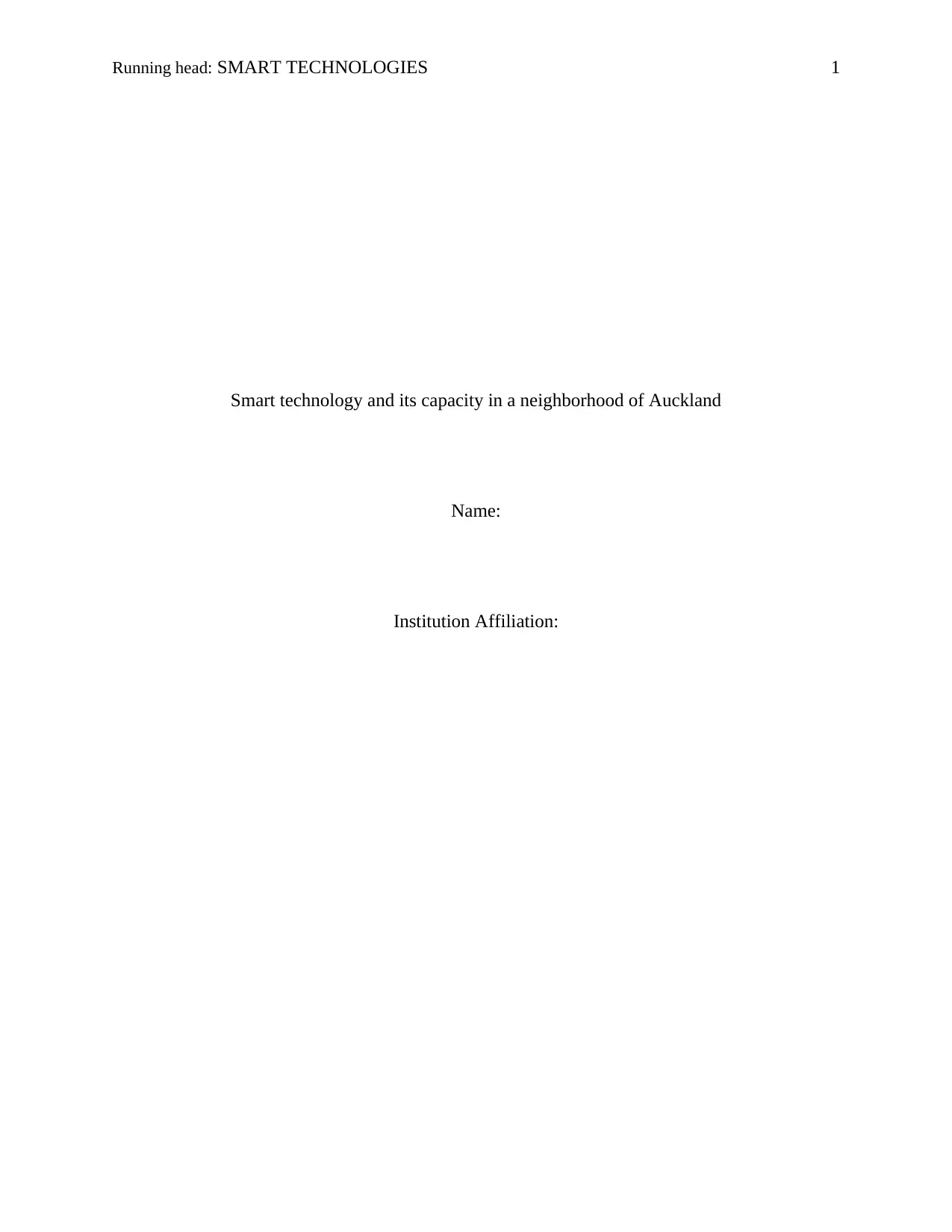
Running head: SMART TECHNOLOGIES 1
Smart technology and its capacity in a neighborhood of Auckland
Name:
Institution Affiliation:
Smart technology and its capacity in a neighborhood of Auckland
Name:
Institution Affiliation:
Paraphrase This Document
Need a fresh take? Get an instant paraphrase of this document with our AI Paraphraser
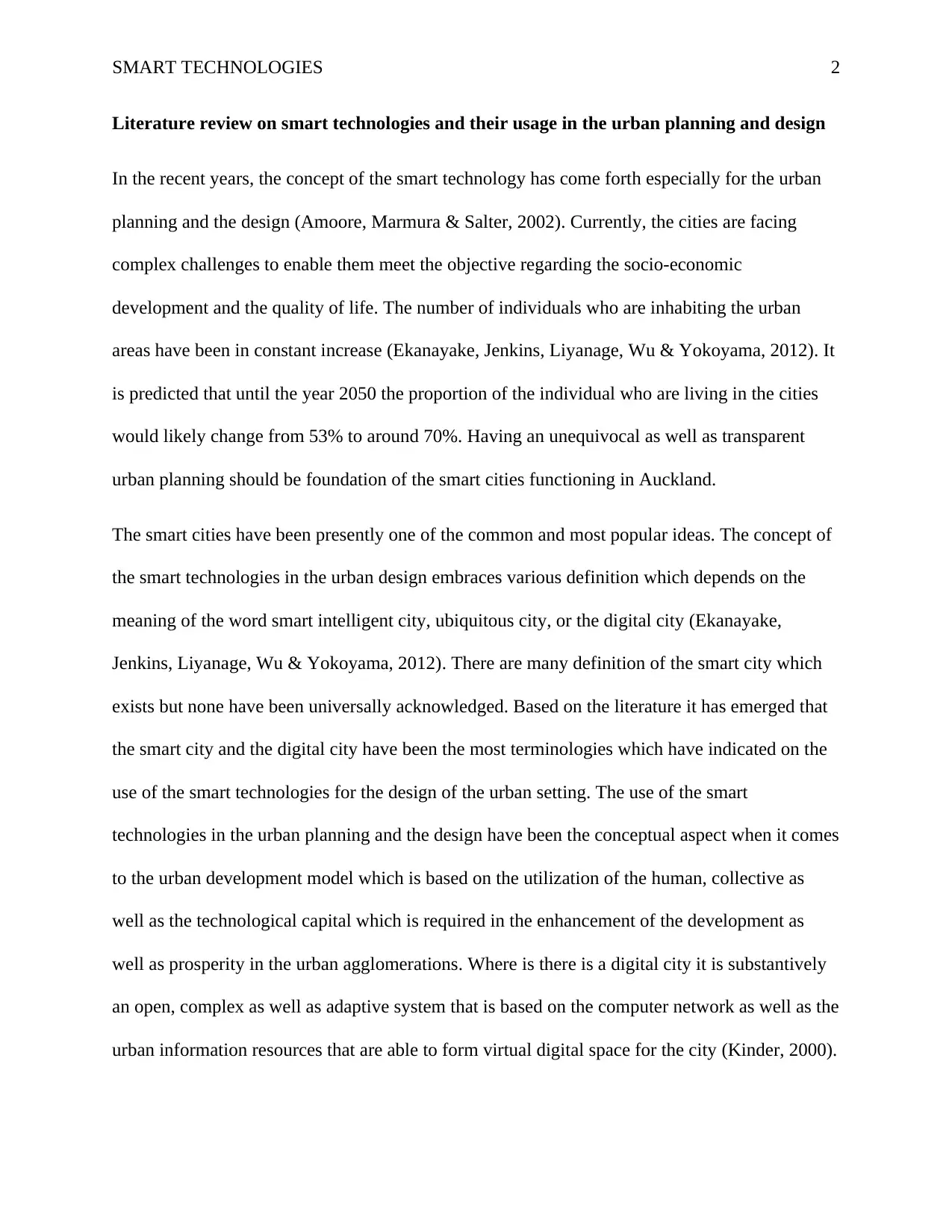
SMART TECHNOLOGIES 2
Literature review on smart technologies and their usage in the urban planning and design
In the recent years, the concept of the smart technology has come forth especially for the urban
planning and the design (Amoore, Marmura & Salter, 2002). Currently, the cities are facing
complex challenges to enable them meet the objective regarding the socio-economic
development and the quality of life. The number of individuals who are inhabiting the urban
areas have been in constant increase (Ekanayake, Jenkins, Liyanage, Wu & Yokoyama, 2012). It
is predicted that until the year 2050 the proportion of the individual who are living in the cities
would likely change from 53% to around 70%. Having an unequivocal as well as transparent
urban planning should be foundation of the smart cities functioning in Auckland.
The smart cities have been presently one of the common and most popular ideas. The concept of
the smart technologies in the urban design embraces various definition which depends on the
meaning of the word smart intelligent city, ubiquitous city, or the digital city (Ekanayake,
Jenkins, Liyanage, Wu & Yokoyama, 2012). There are many definition of the smart city which
exists but none have been universally acknowledged. Based on the literature it has emerged that
the smart city and the digital city have been the most terminologies which have indicated on the
use of the smart technologies for the design of the urban setting. The use of the smart
technologies in the urban planning and the design have been the conceptual aspect when it comes
to the urban development model which is based on the utilization of the human, collective as
well as the technological capital which is required in the enhancement of the development as
well as prosperity in the urban agglomerations. Where is there is a digital city it is substantively
an open, complex as well as adaptive system that is based on the computer network as well as the
urban information resources that are able to form virtual digital space for the city (Kinder, 2000).
Literature review on smart technologies and their usage in the urban planning and design
In the recent years, the concept of the smart technology has come forth especially for the urban
planning and the design (Amoore, Marmura & Salter, 2002). Currently, the cities are facing
complex challenges to enable them meet the objective regarding the socio-economic
development and the quality of life. The number of individuals who are inhabiting the urban
areas have been in constant increase (Ekanayake, Jenkins, Liyanage, Wu & Yokoyama, 2012). It
is predicted that until the year 2050 the proportion of the individual who are living in the cities
would likely change from 53% to around 70%. Having an unequivocal as well as transparent
urban planning should be foundation of the smart cities functioning in Auckland.
The smart cities have been presently one of the common and most popular ideas. The concept of
the smart technologies in the urban design embraces various definition which depends on the
meaning of the word smart intelligent city, ubiquitous city, or the digital city (Ekanayake,
Jenkins, Liyanage, Wu & Yokoyama, 2012). There are many definition of the smart city which
exists but none have been universally acknowledged. Based on the literature it has emerged that
the smart city and the digital city have been the most terminologies which have indicated on the
use of the smart technologies for the design of the urban setting. The use of the smart
technologies in the urban planning and the design have been the conceptual aspect when it comes
to the urban development model which is based on the utilization of the human, collective as
well as the technological capital which is required in the enhancement of the development as
well as prosperity in the urban agglomerations. Where is there is a digital city it is substantively
an open, complex as well as adaptive system that is based on the computer network as well as the
urban information resources that are able to form virtual digital space for the city (Kinder, 2000).
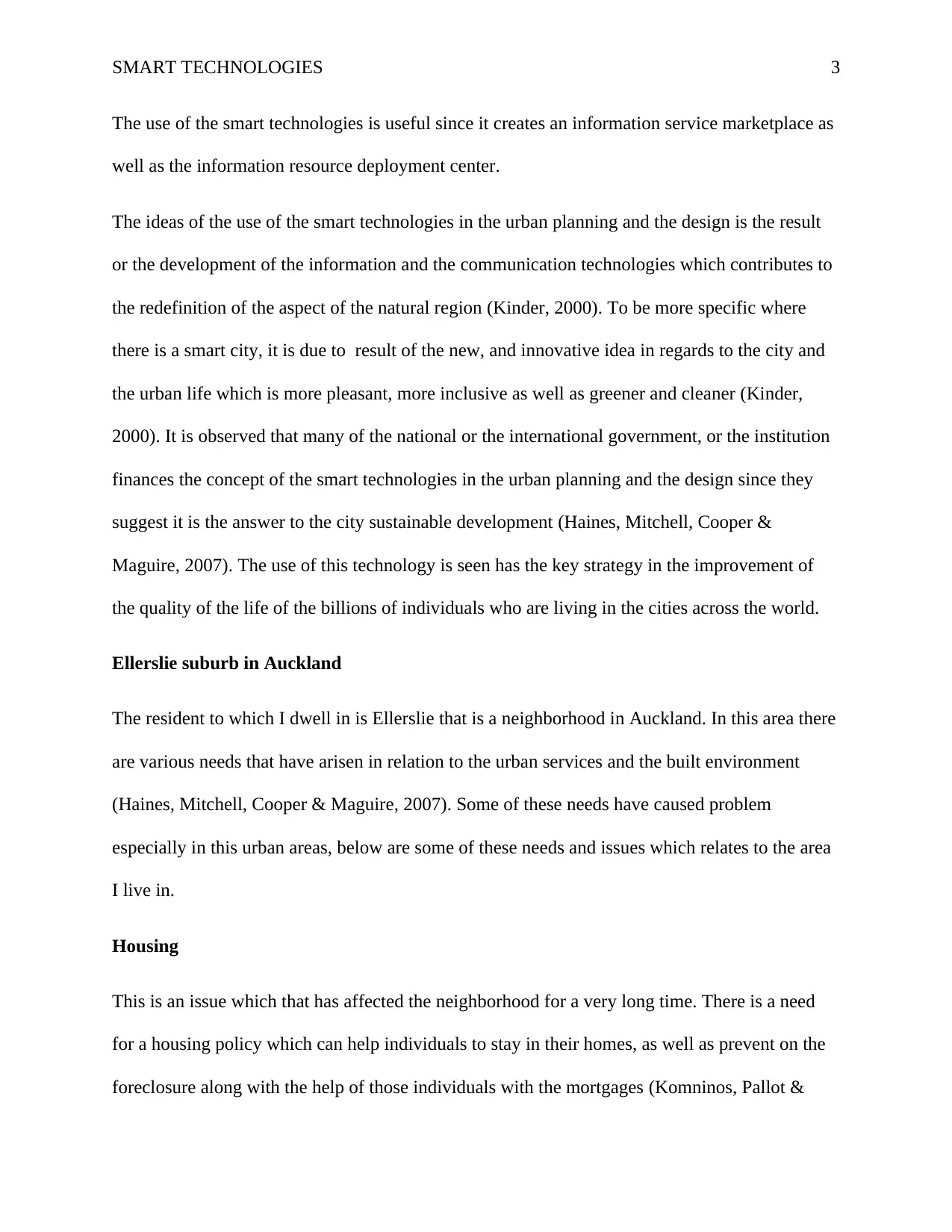
SMART TECHNOLOGIES 3
The use of the smart technologies is useful since it creates an information service marketplace as
well as the information resource deployment center.
The ideas of the use of the smart technologies in the urban planning and the design is the result
or the development of the information and the communication technologies which contributes to
the redefinition of the aspect of the natural region (Kinder, 2000). To be more specific where
there is a smart city, it is due to result of the new, and innovative idea in regards to the city and
the urban life which is more pleasant, more inclusive as well as greener and cleaner (Kinder,
2000). It is observed that many of the national or the international government, or the institution
finances the concept of the smart technologies in the urban planning and the design since they
suggest it is the answer to the city sustainable development (Haines, Mitchell, Cooper &
Maguire, 2007). The use of this technology is seen has the key strategy in the improvement of
the quality of the life of the billions of individuals who are living in the cities across the world.
Ellerslie suburb in Auckland
The resident to which I dwell in is Ellerslie that is a neighborhood in Auckland. In this area there
are various needs that have arisen in relation to the urban services and the built environment
(Haines, Mitchell, Cooper & Maguire, 2007). Some of these needs have caused problem
especially in this urban areas, below are some of these needs and issues which relates to the area
I live in.
Housing
This is an issue which that has affected the neighborhood for a very long time. There is a need
for a housing policy which can help individuals to stay in their homes, as well as prevent on the
foreclosure along with the help of those individuals with the mortgages (Komninos, Pallot &
The use of the smart technologies is useful since it creates an information service marketplace as
well as the information resource deployment center.
The ideas of the use of the smart technologies in the urban planning and the design is the result
or the development of the information and the communication technologies which contributes to
the redefinition of the aspect of the natural region (Kinder, 2000). To be more specific where
there is a smart city, it is due to result of the new, and innovative idea in regards to the city and
the urban life which is more pleasant, more inclusive as well as greener and cleaner (Kinder,
2000). It is observed that many of the national or the international government, or the institution
finances the concept of the smart technologies in the urban planning and the design since they
suggest it is the answer to the city sustainable development (Haines, Mitchell, Cooper &
Maguire, 2007). The use of this technology is seen has the key strategy in the improvement of
the quality of the life of the billions of individuals who are living in the cities across the world.
Ellerslie suburb in Auckland
The resident to which I dwell in is Ellerslie that is a neighborhood in Auckland. In this area there
are various needs that have arisen in relation to the urban services and the built environment
(Haines, Mitchell, Cooper & Maguire, 2007). Some of these needs have caused problem
especially in this urban areas, below are some of these needs and issues which relates to the area
I live in.
Housing
This is an issue which that has affected the neighborhood for a very long time. There is a need
for a housing policy which can help individuals to stay in their homes, as well as prevent on the
foreclosure along with the help of those individuals with the mortgages (Komninos, Pallot &
⊘ This is a preview!⊘
Do you want full access?
Subscribe today to unlock all pages.

Trusted by 1+ million students worldwide
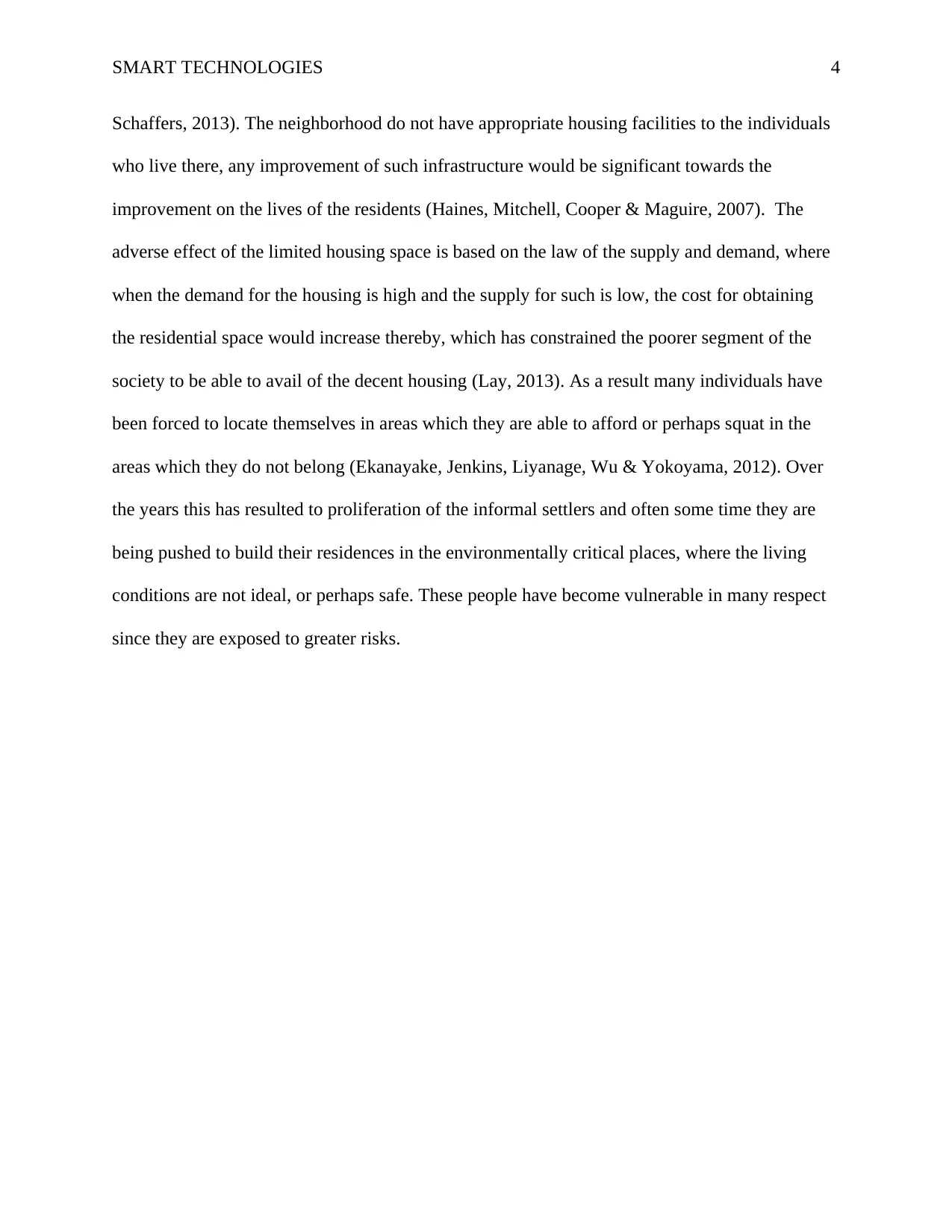
SMART TECHNOLOGIES 4
Schaffers, 2013). The neighborhood do not have appropriate housing facilities to the individuals
who live there, any improvement of such infrastructure would be significant towards the
improvement on the lives of the residents (Haines, Mitchell, Cooper & Maguire, 2007). The
adverse effect of the limited housing space is based on the law of the supply and demand, where
when the demand for the housing is high and the supply for such is low, the cost for obtaining
the residential space would increase thereby, which has constrained the poorer segment of the
society to be able to avail of the decent housing (Lay, 2013). As a result many individuals have
been forced to locate themselves in areas which they are able to afford or perhaps squat in the
areas which they do not belong (Ekanayake, Jenkins, Liyanage, Wu & Yokoyama, 2012). Over
the years this has resulted to proliferation of the informal settlers and often some time they are
being pushed to build their residences in the environmentally critical places, where the living
conditions are not ideal, or perhaps safe. These people have become vulnerable in many respect
since they are exposed to greater risks.
Schaffers, 2013). The neighborhood do not have appropriate housing facilities to the individuals
who live there, any improvement of such infrastructure would be significant towards the
improvement on the lives of the residents (Haines, Mitchell, Cooper & Maguire, 2007). The
adverse effect of the limited housing space is based on the law of the supply and demand, where
when the demand for the housing is high and the supply for such is low, the cost for obtaining
the residential space would increase thereby, which has constrained the poorer segment of the
society to be able to avail of the decent housing (Lay, 2013). As a result many individuals have
been forced to locate themselves in areas which they are able to afford or perhaps squat in the
areas which they do not belong (Ekanayake, Jenkins, Liyanage, Wu & Yokoyama, 2012). Over
the years this has resulted to proliferation of the informal settlers and often some time they are
being pushed to build their residences in the environmentally critical places, where the living
conditions are not ideal, or perhaps safe. These people have become vulnerable in many respect
since they are exposed to greater risks.
Paraphrase This Document
Need a fresh take? Get an instant paraphrase of this document with our AI Paraphraser
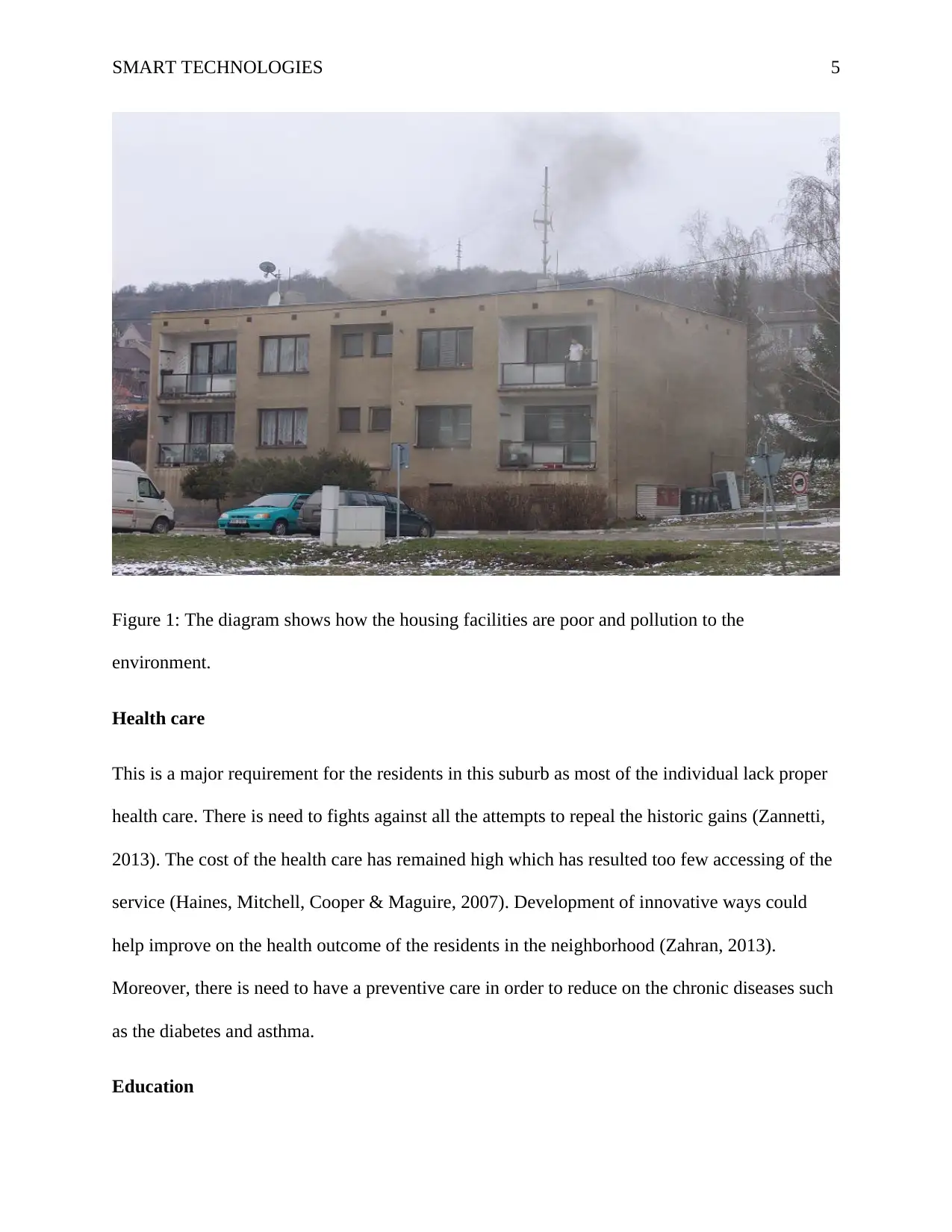
SMART TECHNOLOGIES 5
Figure 1: The diagram shows how the housing facilities are poor and pollution to the
environment.
Health care
This is a major requirement for the residents in this suburb as most of the individual lack proper
health care. There is need to fights against all the attempts to repeal the historic gains (Zannetti,
2013). The cost of the health care has remained high which has resulted too few accessing of the
service (Haines, Mitchell, Cooper & Maguire, 2007). Development of innovative ways could
help improve on the health outcome of the residents in the neighborhood (Zahran, 2013).
Moreover, there is need to have a preventive care in order to reduce on the chronic diseases such
as the diabetes and asthma.
Education
Figure 1: The diagram shows how the housing facilities are poor and pollution to the
environment.
Health care
This is a major requirement for the residents in this suburb as most of the individual lack proper
health care. There is need to fights against all the attempts to repeal the historic gains (Zannetti,
2013). The cost of the health care has remained high which has resulted too few accessing of the
service (Haines, Mitchell, Cooper & Maguire, 2007). Development of innovative ways could
help improve on the health outcome of the residents in the neighborhood (Zahran, 2013).
Moreover, there is need to have a preventive care in order to reduce on the chronic diseases such
as the diabetes and asthma.
Education
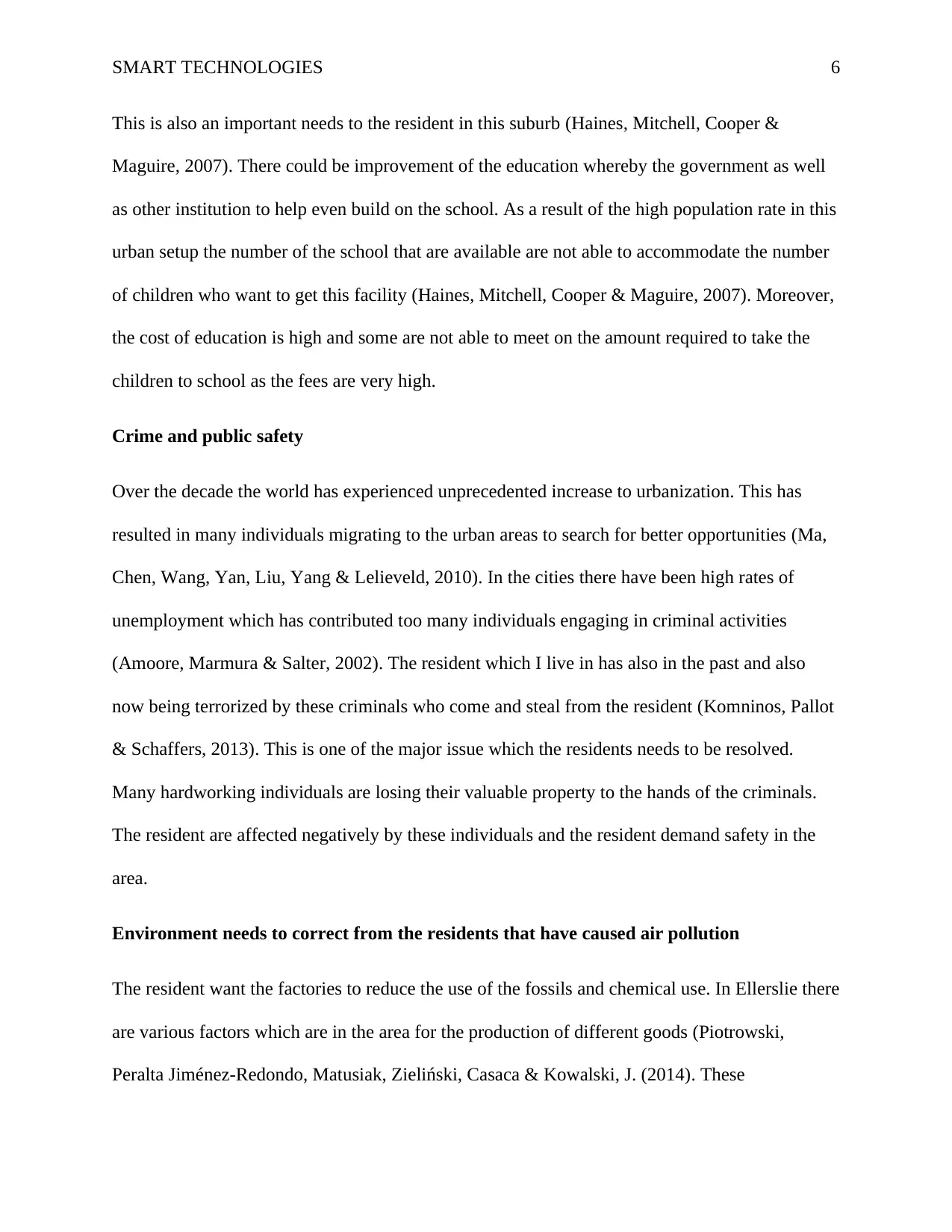
SMART TECHNOLOGIES 6
This is also an important needs to the resident in this suburb (Haines, Mitchell, Cooper &
Maguire, 2007). There could be improvement of the education whereby the government as well
as other institution to help even build on the school. As a result of the high population rate in this
urban setup the number of the school that are available are not able to accommodate the number
of children who want to get this facility (Haines, Mitchell, Cooper & Maguire, 2007). Moreover,
the cost of education is high and some are not able to meet on the amount required to take the
children to school as the fees are very high.
Crime and public safety
Over the decade the world has experienced unprecedented increase to urbanization. This has
resulted in many individuals migrating to the urban areas to search for better opportunities (Ma,
Chen, Wang, Yan, Liu, Yang & Lelieveld, 2010). In the cities there have been high rates of
unemployment which has contributed too many individuals engaging in criminal activities
(Amoore, Marmura & Salter, 2002). The resident which I live in has also in the past and also
now being terrorized by these criminals who come and steal from the resident (Komninos, Pallot
& Schaffers, 2013). This is one of the major issue which the residents needs to be resolved.
Many hardworking individuals are losing their valuable property to the hands of the criminals.
The resident are affected negatively by these individuals and the resident demand safety in the
area.
Environment needs to correct from the residents that have caused air pollution
The resident want the factories to reduce the use of the fossils and chemical use. In Ellerslie there
are various factors which are in the area for the production of different goods (Piotrowski,
Peralta Jiménez-Redondo, Matusiak, Zieliński, Casaca & Kowalski, J. (2014). These
This is also an important needs to the resident in this suburb (Haines, Mitchell, Cooper &
Maguire, 2007). There could be improvement of the education whereby the government as well
as other institution to help even build on the school. As a result of the high population rate in this
urban setup the number of the school that are available are not able to accommodate the number
of children who want to get this facility (Haines, Mitchell, Cooper & Maguire, 2007). Moreover,
the cost of education is high and some are not able to meet on the amount required to take the
children to school as the fees are very high.
Crime and public safety
Over the decade the world has experienced unprecedented increase to urbanization. This has
resulted in many individuals migrating to the urban areas to search for better opportunities (Ma,
Chen, Wang, Yan, Liu, Yang & Lelieveld, 2010). In the cities there have been high rates of
unemployment which has contributed too many individuals engaging in criminal activities
(Amoore, Marmura & Salter, 2002). The resident which I live in has also in the past and also
now being terrorized by these criminals who come and steal from the resident (Komninos, Pallot
& Schaffers, 2013). This is one of the major issue which the residents needs to be resolved.
Many hardworking individuals are losing their valuable property to the hands of the criminals.
The resident are affected negatively by these individuals and the resident demand safety in the
area.
Environment needs to correct from the residents that have caused air pollution
The resident want the factories to reduce the use of the fossils and chemical use. In Ellerslie there
are various factors which are in the area for the production of different goods (Piotrowski,
Peralta Jiménez-Redondo, Matusiak, Zieliński, Casaca & Kowalski, J. (2014). These
⊘ This is a preview!⊘
Do you want full access?
Subscribe today to unlock all pages.

Trusted by 1+ million students worldwide
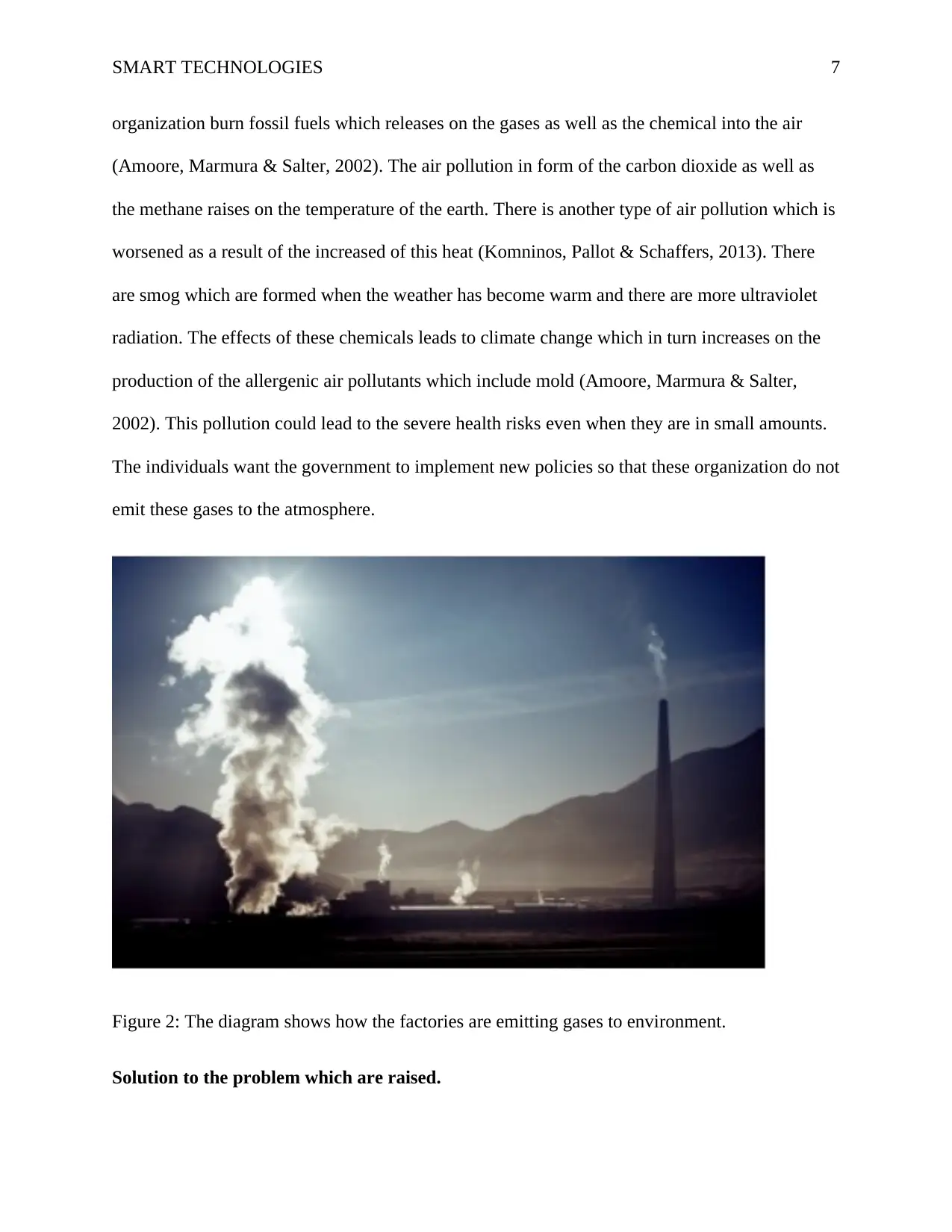
SMART TECHNOLOGIES 7
organization burn fossil fuels which releases on the gases as well as the chemical into the air
(Amoore, Marmura & Salter, 2002). The air pollution in form of the carbon dioxide as well as
the methane raises on the temperature of the earth. There is another type of air pollution which is
worsened as a result of the increased of this heat (Komninos, Pallot & Schaffers, 2013). There
are smog which are formed when the weather has become warm and there are more ultraviolet
radiation. The effects of these chemicals leads to climate change which in turn increases on the
production of the allergenic air pollutants which include mold (Amoore, Marmura & Salter,
2002). This pollution could lead to the severe health risks even when they are in small amounts.
The individuals want the government to implement new policies so that these organization do not
emit these gases to the atmosphere.
Figure 2: The diagram shows how the factories are emitting gases to environment.
Solution to the problem which are raised.
organization burn fossil fuels which releases on the gases as well as the chemical into the air
(Amoore, Marmura & Salter, 2002). The air pollution in form of the carbon dioxide as well as
the methane raises on the temperature of the earth. There is another type of air pollution which is
worsened as a result of the increased of this heat (Komninos, Pallot & Schaffers, 2013). There
are smog which are formed when the weather has become warm and there are more ultraviolet
radiation. The effects of these chemicals leads to climate change which in turn increases on the
production of the allergenic air pollutants which include mold (Amoore, Marmura & Salter,
2002). This pollution could lead to the severe health risks even when they are in small amounts.
The individuals want the government to implement new policies so that these organization do not
emit these gases to the atmosphere.
Figure 2: The diagram shows how the factories are emitting gases to environment.
Solution to the problem which are raised.
Paraphrase This Document
Need a fresh take? Get an instant paraphrase of this document with our AI Paraphraser
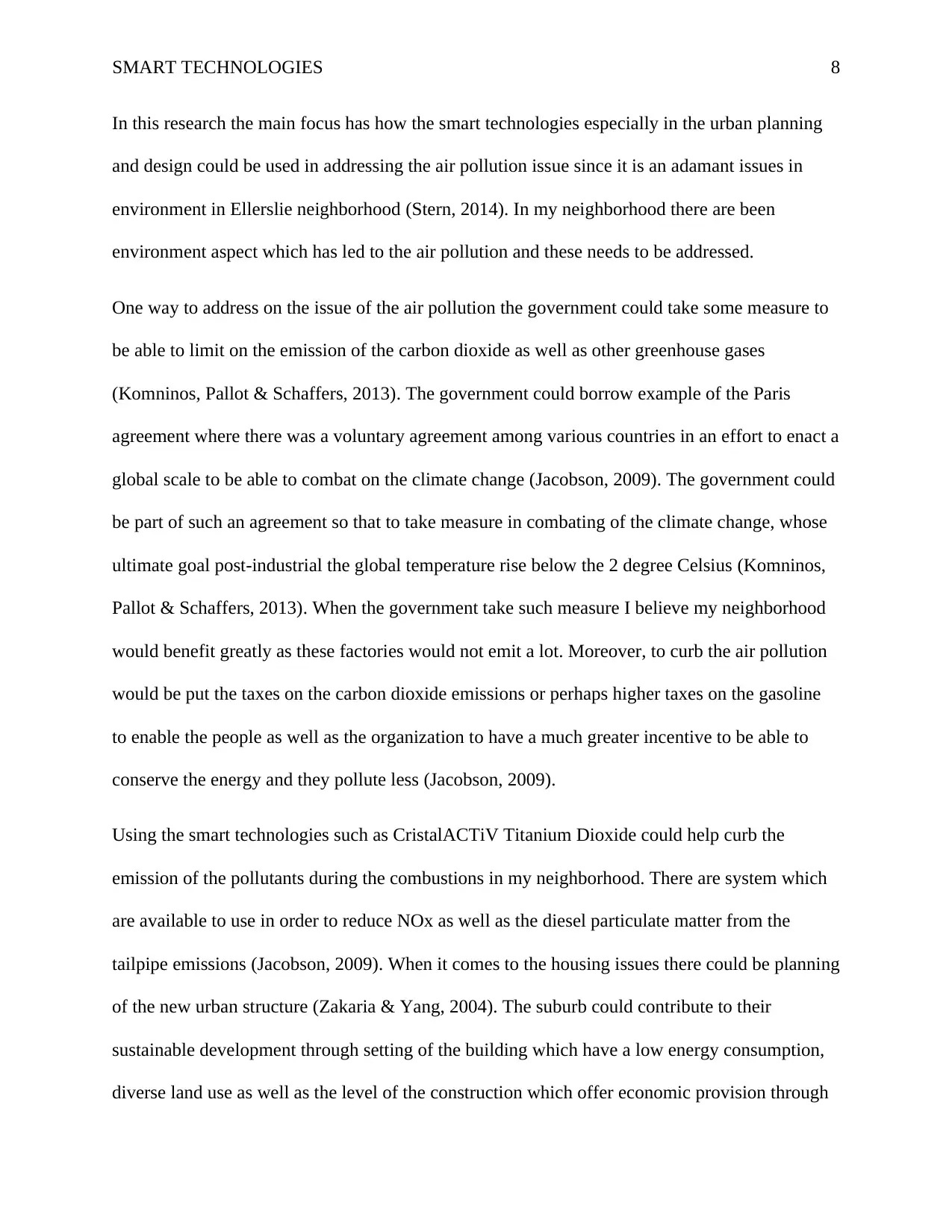
SMART TECHNOLOGIES 8
In this research the main focus has how the smart technologies especially in the urban planning
and design could be used in addressing the air pollution issue since it is an adamant issues in
environment in Ellerslie neighborhood (Stern, 2014). In my neighborhood there are been
environment aspect which has led to the air pollution and these needs to be addressed.
One way to address on the issue of the air pollution the government could take some measure to
be able to limit on the emission of the carbon dioxide as well as other greenhouse gases
(Komninos, Pallot & Schaffers, 2013). The government could borrow example of the Paris
agreement where there was a voluntary agreement among various countries in an effort to enact a
global scale to be able to combat on the climate change (Jacobson, 2009). The government could
be part of such an agreement so that to take measure in combating of the climate change, whose
ultimate goal post-industrial the global temperature rise below the 2 degree Celsius (Komninos,
Pallot & Schaffers, 2013). When the government take such measure I believe my neighborhood
would benefit greatly as these factories would not emit a lot. Moreover, to curb the air pollution
would be put the taxes on the carbon dioxide emissions or perhaps higher taxes on the gasoline
to enable the people as well as the organization to have a much greater incentive to be able to
conserve the energy and they pollute less (Jacobson, 2009).
Using the smart technologies such as CristalACTiV Titanium Dioxide could help curb the
emission of the pollutants during the combustions in my neighborhood. There are system which
are available to use in order to reduce NOx as well as the diesel particulate matter from the
tailpipe emissions (Jacobson, 2009). When it comes to the housing issues there could be planning
of the new urban structure (Zakaria & Yang, 2004). The suburb could contribute to their
sustainable development through setting of the building which have a low energy consumption,
diverse land use as well as the level of the construction which offer economic provision through
In this research the main focus has how the smart technologies especially in the urban planning
and design could be used in addressing the air pollution issue since it is an adamant issues in
environment in Ellerslie neighborhood (Stern, 2014). In my neighborhood there are been
environment aspect which has led to the air pollution and these needs to be addressed.
One way to address on the issue of the air pollution the government could take some measure to
be able to limit on the emission of the carbon dioxide as well as other greenhouse gases
(Komninos, Pallot & Schaffers, 2013). The government could borrow example of the Paris
agreement where there was a voluntary agreement among various countries in an effort to enact a
global scale to be able to combat on the climate change (Jacobson, 2009). The government could
be part of such an agreement so that to take measure in combating of the climate change, whose
ultimate goal post-industrial the global temperature rise below the 2 degree Celsius (Komninos,
Pallot & Schaffers, 2013). When the government take such measure I believe my neighborhood
would benefit greatly as these factories would not emit a lot. Moreover, to curb the air pollution
would be put the taxes on the carbon dioxide emissions or perhaps higher taxes on the gasoline
to enable the people as well as the organization to have a much greater incentive to be able to
conserve the energy and they pollute less (Jacobson, 2009).
Using the smart technologies such as CristalACTiV Titanium Dioxide could help curb the
emission of the pollutants during the combustions in my neighborhood. There are system which
are available to use in order to reduce NOx as well as the diesel particulate matter from the
tailpipe emissions (Jacobson, 2009). When it comes to the housing issues there could be planning
of the new urban structure (Zakaria & Yang, 2004). The suburb could contribute to their
sustainable development through setting of the building which have a low energy consumption,
diverse land use as well as the level of the construction which offer economic provision through
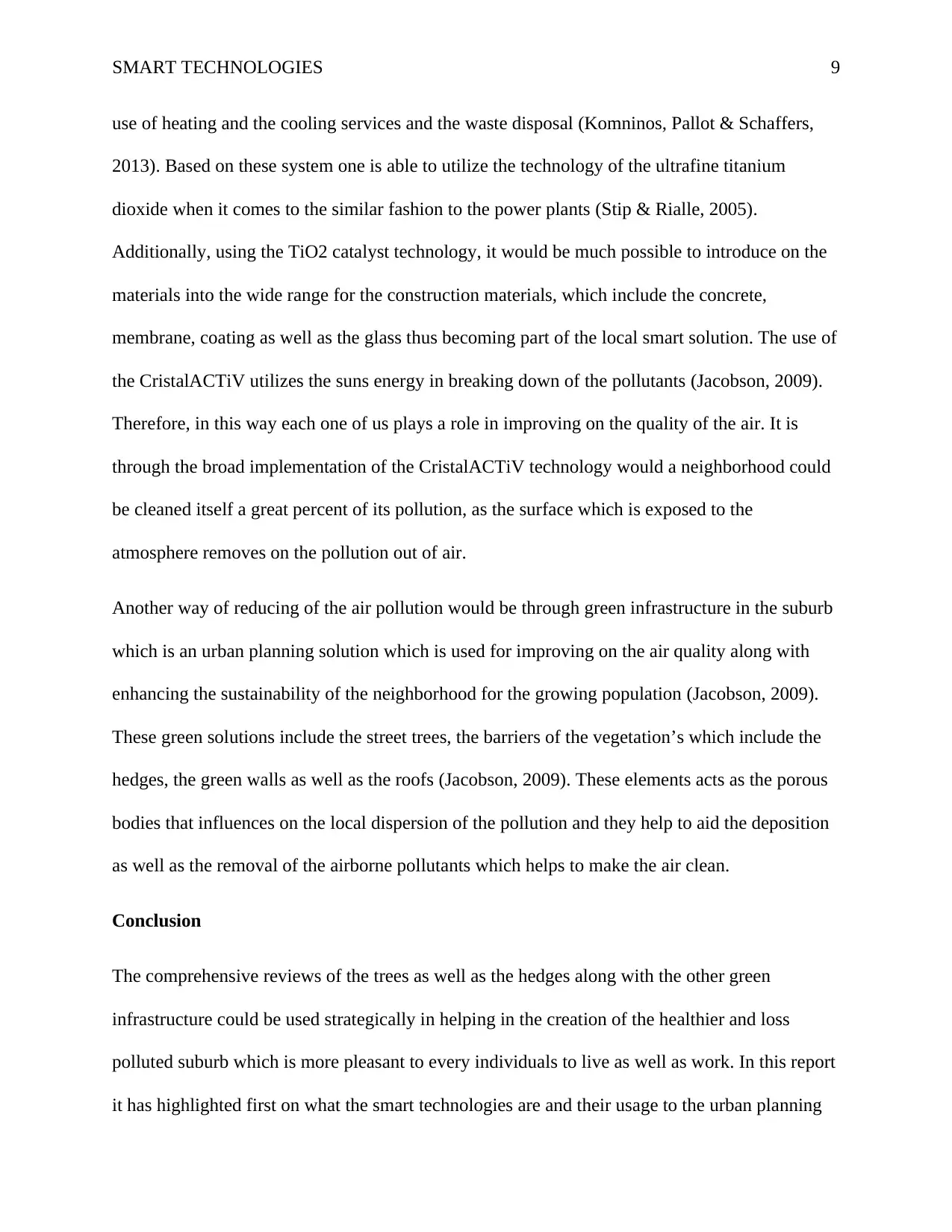
SMART TECHNOLOGIES 9
use of heating and the cooling services and the waste disposal (Komninos, Pallot & Schaffers,
2013). Based on these system one is able to utilize the technology of the ultrafine titanium
dioxide when it comes to the similar fashion to the power plants (Stip & Rialle, 2005).
Additionally, using the TiO2 catalyst technology, it would be much possible to introduce on the
materials into the wide range for the construction materials, which include the concrete,
membrane, coating as well as the glass thus becoming part of the local smart solution. The use of
the CristalACTiV utilizes the suns energy in breaking down of the pollutants (Jacobson, 2009).
Therefore, in this way each one of us plays a role in improving on the quality of the air. It is
through the broad implementation of the CristalACTiV technology would a neighborhood could
be cleaned itself a great percent of its pollution, as the surface which is exposed to the
atmosphere removes on the pollution out of air.
Another way of reducing of the air pollution would be through green infrastructure in the suburb
which is an urban planning solution which is used for improving on the air quality along with
enhancing the sustainability of the neighborhood for the growing population (Jacobson, 2009).
These green solutions include the street trees, the barriers of the vegetation’s which include the
hedges, the green walls as well as the roofs (Jacobson, 2009). These elements acts as the porous
bodies that influences on the local dispersion of the pollution and they help to aid the deposition
as well as the removal of the airborne pollutants which helps to make the air clean.
Conclusion
The comprehensive reviews of the trees as well as the hedges along with the other green
infrastructure could be used strategically in helping in the creation of the healthier and loss
polluted suburb which is more pleasant to every individuals to live as well as work. In this report
it has highlighted first on what the smart technologies are and their usage to the urban planning
use of heating and the cooling services and the waste disposal (Komninos, Pallot & Schaffers,
2013). Based on these system one is able to utilize the technology of the ultrafine titanium
dioxide when it comes to the similar fashion to the power plants (Stip & Rialle, 2005).
Additionally, using the TiO2 catalyst technology, it would be much possible to introduce on the
materials into the wide range for the construction materials, which include the concrete,
membrane, coating as well as the glass thus becoming part of the local smart solution. The use of
the CristalACTiV utilizes the suns energy in breaking down of the pollutants (Jacobson, 2009).
Therefore, in this way each one of us plays a role in improving on the quality of the air. It is
through the broad implementation of the CristalACTiV technology would a neighborhood could
be cleaned itself a great percent of its pollution, as the surface which is exposed to the
atmosphere removes on the pollution out of air.
Another way of reducing of the air pollution would be through green infrastructure in the suburb
which is an urban planning solution which is used for improving on the air quality along with
enhancing the sustainability of the neighborhood for the growing population (Jacobson, 2009).
These green solutions include the street trees, the barriers of the vegetation’s which include the
hedges, the green walls as well as the roofs (Jacobson, 2009). These elements acts as the porous
bodies that influences on the local dispersion of the pollution and they help to aid the deposition
as well as the removal of the airborne pollutants which helps to make the air clean.
Conclusion
The comprehensive reviews of the trees as well as the hedges along with the other green
infrastructure could be used strategically in helping in the creation of the healthier and loss
polluted suburb which is more pleasant to every individuals to live as well as work. In this report
it has highlighted first on what the smart technologies are and their usage to the urban planning
⊘ This is a preview!⊘
Do you want full access?
Subscribe today to unlock all pages.

Trusted by 1+ million students worldwide
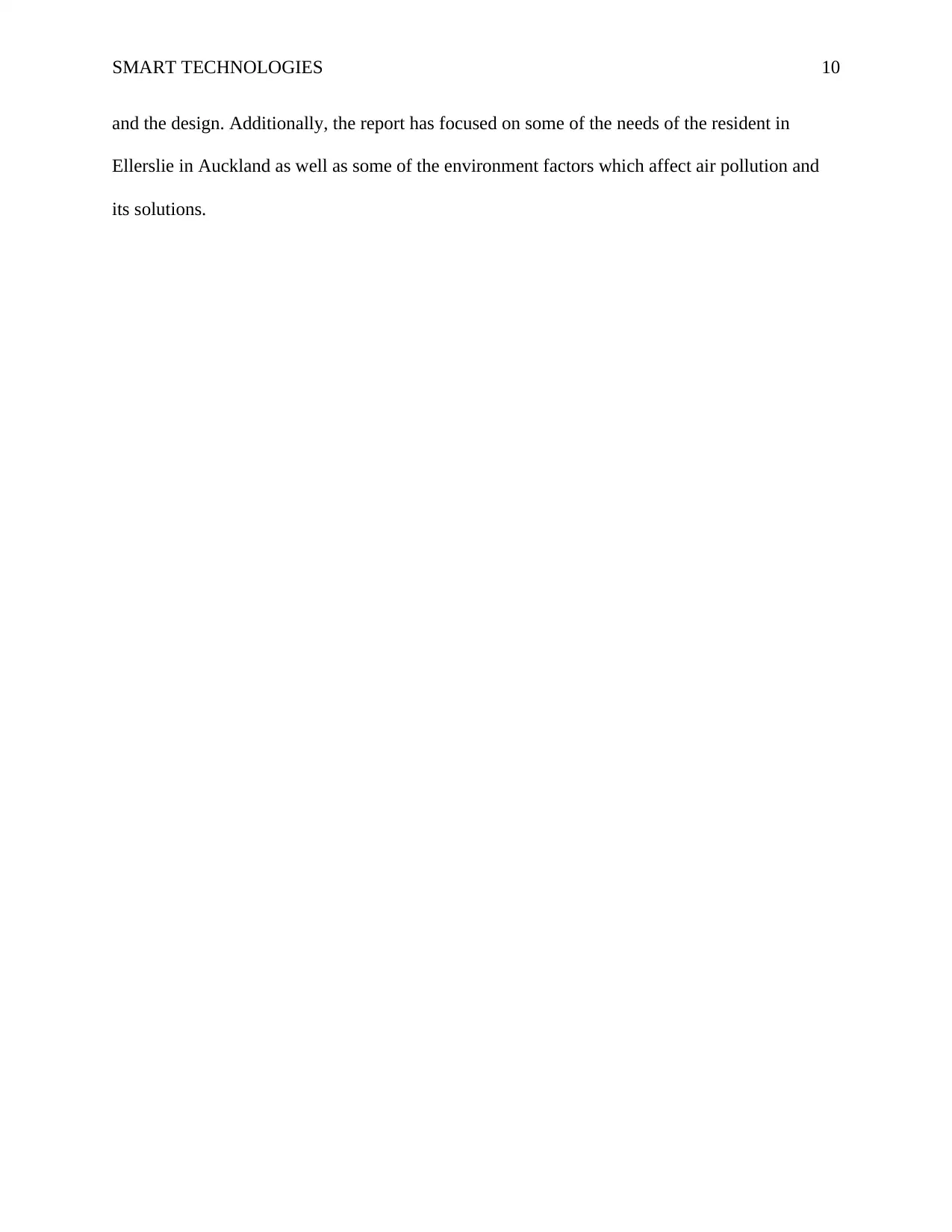
SMART TECHNOLOGIES 10
and the design. Additionally, the report has focused on some of the needs of the resident in
Ellerslie in Auckland as well as some of the environment factors which affect air pollution and
its solutions.
and the design. Additionally, the report has focused on some of the needs of the resident in
Ellerslie in Auckland as well as some of the environment factors which affect air pollution and
its solutions.
Paraphrase This Document
Need a fresh take? Get an instant paraphrase of this document with our AI Paraphraser
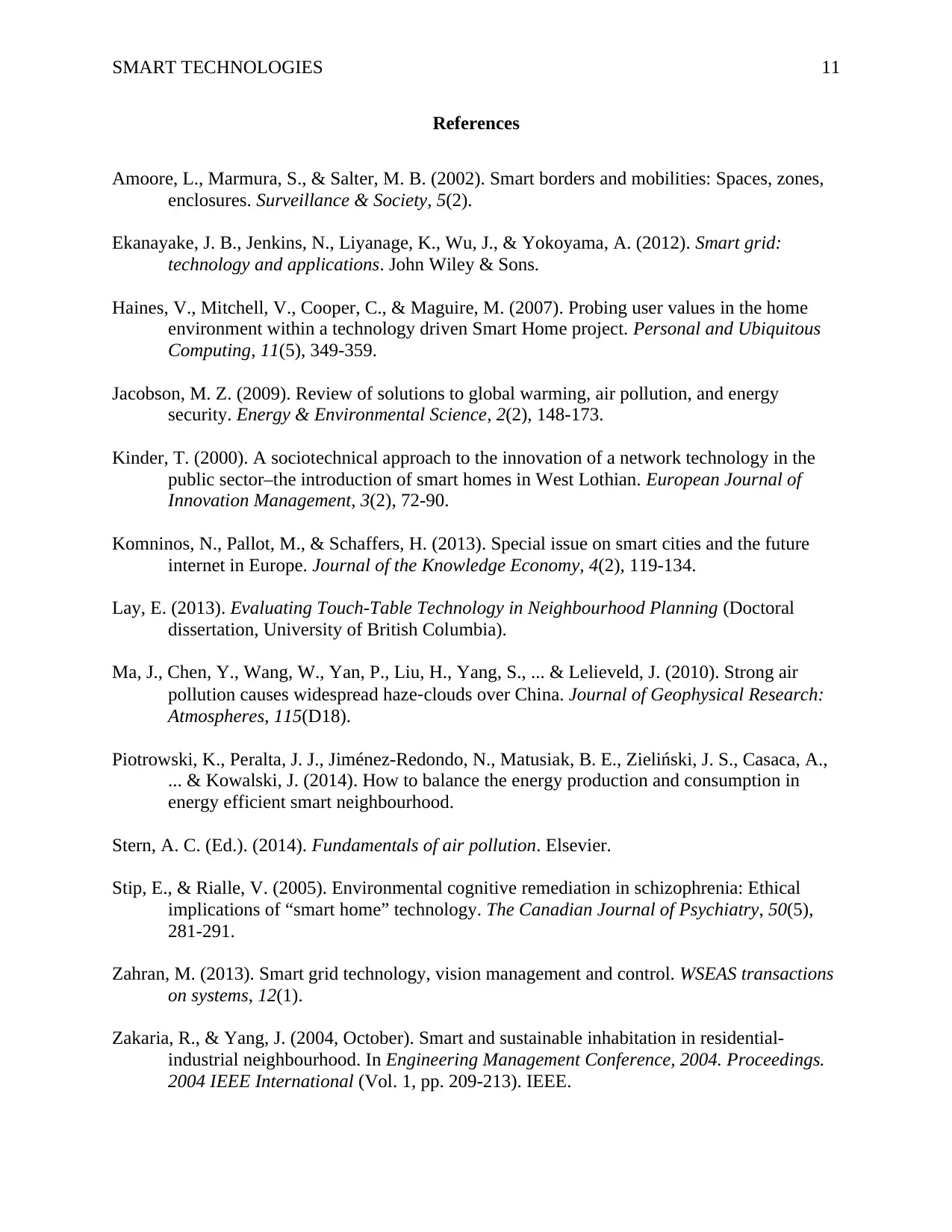
SMART TECHNOLOGIES 11
References
Amoore, L., Marmura, S., & Salter, M. B. (2002). Smart borders and mobilities: Spaces, zones,
enclosures. Surveillance & Society, 5(2).
Ekanayake, J. B., Jenkins, N., Liyanage, K., Wu, J., & Yokoyama, A. (2012). Smart grid:
technology and applications. John Wiley & Sons.
Haines, V., Mitchell, V., Cooper, C., & Maguire, M. (2007). Probing user values in the home
environment within a technology driven Smart Home project. Personal and Ubiquitous
Computing, 11(5), 349-359.
Jacobson, M. Z. (2009). Review of solutions to global warming, air pollution, and energy
security. Energy & Environmental Science, 2(2), 148-173.
Kinder, T. (2000). A sociotechnical approach to the innovation of a network technology in the
public sector–the introduction of smart homes in West Lothian. European Journal of
Innovation Management, 3(2), 72-90.
Komninos, N., Pallot, M., & Schaffers, H. (2013). Special issue on smart cities and the future
internet in Europe. Journal of the Knowledge Economy, 4(2), 119-134.
Lay, E. (2013). Evaluating Touch-Table Technology in Neighbourhood Planning (Doctoral
dissertation, University of British Columbia).
Ma, J., Chen, Y., Wang, W., Yan, P., Liu, H., Yang, S., ... & Lelieveld, J. (2010). Strong air
pollution causes widespread haze‐clouds over China. Journal of Geophysical Research:
Atmospheres, 115(D18).
Piotrowski, K., Peralta, J. J., Jiménez-Redondo, N., Matusiak, B. E., Zieliński, J. S., Casaca, A.,
... & Kowalski, J. (2014). How to balance the energy production and consumption in
energy efficient smart neighbourhood.
Stern, A. C. (Ed.). (2014). Fundamentals of air pollution. Elsevier.
Stip, E., & Rialle, V. (2005). Environmental cognitive remediation in schizophrenia: Ethical
implications of “smart home” technology. The Canadian Journal of Psychiatry, 50(5),
281-291.
Zahran, M. (2013). Smart grid technology, vision management and control. WSEAS transactions
on systems, 12(1).
Zakaria, R., & Yang, J. (2004, October). Smart and sustainable inhabitation in residential-
industrial neighbourhood. In Engineering Management Conference, 2004. Proceedings.
2004 IEEE International (Vol. 1, pp. 209-213). IEEE.
References
Amoore, L., Marmura, S., & Salter, M. B. (2002). Smart borders and mobilities: Spaces, zones,
enclosures. Surveillance & Society, 5(2).
Ekanayake, J. B., Jenkins, N., Liyanage, K., Wu, J., & Yokoyama, A. (2012). Smart grid:
technology and applications. John Wiley & Sons.
Haines, V., Mitchell, V., Cooper, C., & Maguire, M. (2007). Probing user values in the home
environment within a technology driven Smart Home project. Personal and Ubiquitous
Computing, 11(5), 349-359.
Jacobson, M. Z. (2009). Review of solutions to global warming, air pollution, and energy
security. Energy & Environmental Science, 2(2), 148-173.
Kinder, T. (2000). A sociotechnical approach to the innovation of a network technology in the
public sector–the introduction of smart homes in West Lothian. European Journal of
Innovation Management, 3(2), 72-90.
Komninos, N., Pallot, M., & Schaffers, H. (2013). Special issue on smart cities and the future
internet in Europe. Journal of the Knowledge Economy, 4(2), 119-134.
Lay, E. (2013). Evaluating Touch-Table Technology in Neighbourhood Planning (Doctoral
dissertation, University of British Columbia).
Ma, J., Chen, Y., Wang, W., Yan, P., Liu, H., Yang, S., ... & Lelieveld, J. (2010). Strong air
pollution causes widespread haze‐clouds over China. Journal of Geophysical Research:
Atmospheres, 115(D18).
Piotrowski, K., Peralta, J. J., Jiménez-Redondo, N., Matusiak, B. E., Zieliński, J. S., Casaca, A.,
... & Kowalski, J. (2014). How to balance the energy production and consumption in
energy efficient smart neighbourhood.
Stern, A. C. (Ed.). (2014). Fundamentals of air pollution. Elsevier.
Stip, E., & Rialle, V. (2005). Environmental cognitive remediation in schizophrenia: Ethical
implications of “smart home” technology. The Canadian Journal of Psychiatry, 50(5),
281-291.
Zahran, M. (2013). Smart grid technology, vision management and control. WSEAS transactions
on systems, 12(1).
Zakaria, R., & Yang, J. (2004, October). Smart and sustainable inhabitation in residential-
industrial neighbourhood. In Engineering Management Conference, 2004. Proceedings.
2004 IEEE International (Vol. 1, pp. 209-213). IEEE.
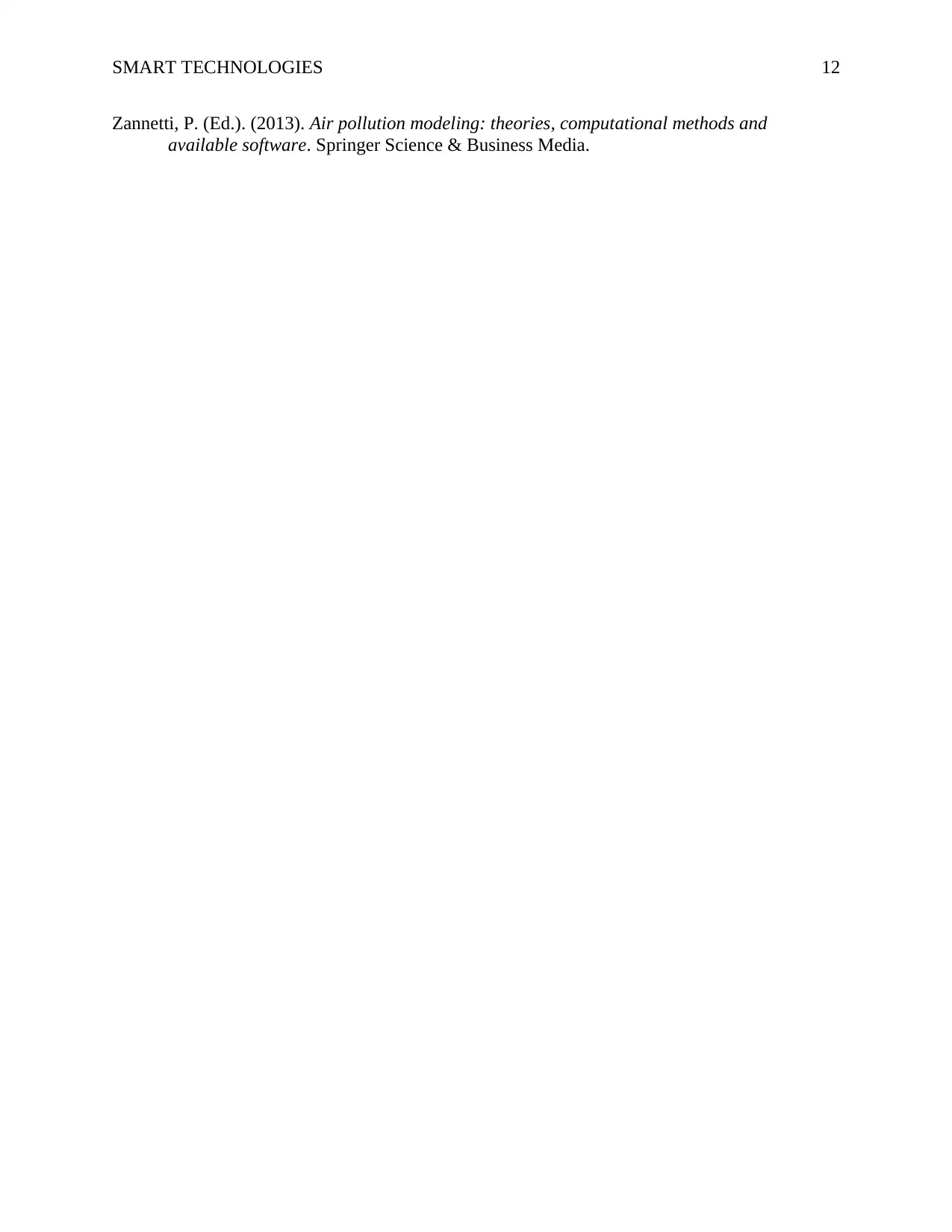
SMART TECHNOLOGIES 12
Zannetti, P. (Ed.). (2013). Air pollution modeling: theories, computational methods and
available software. Springer Science & Business Media.
Zannetti, P. (Ed.). (2013). Air pollution modeling: theories, computational methods and
available software. Springer Science & Business Media.
⊘ This is a preview!⊘
Do you want full access?
Subscribe today to unlock all pages.

Trusted by 1+ million students worldwide
1 out of 12
Related Documents
Your All-in-One AI-Powered Toolkit for Academic Success.
+13062052269
info@desklib.com
Available 24*7 on WhatsApp / Email
![[object Object]](/_next/static/media/star-bottom.7253800d.svg)
Unlock your academic potential
Copyright © 2020–2025 A2Z Services. All Rights Reserved. Developed and managed by ZUCOL.




